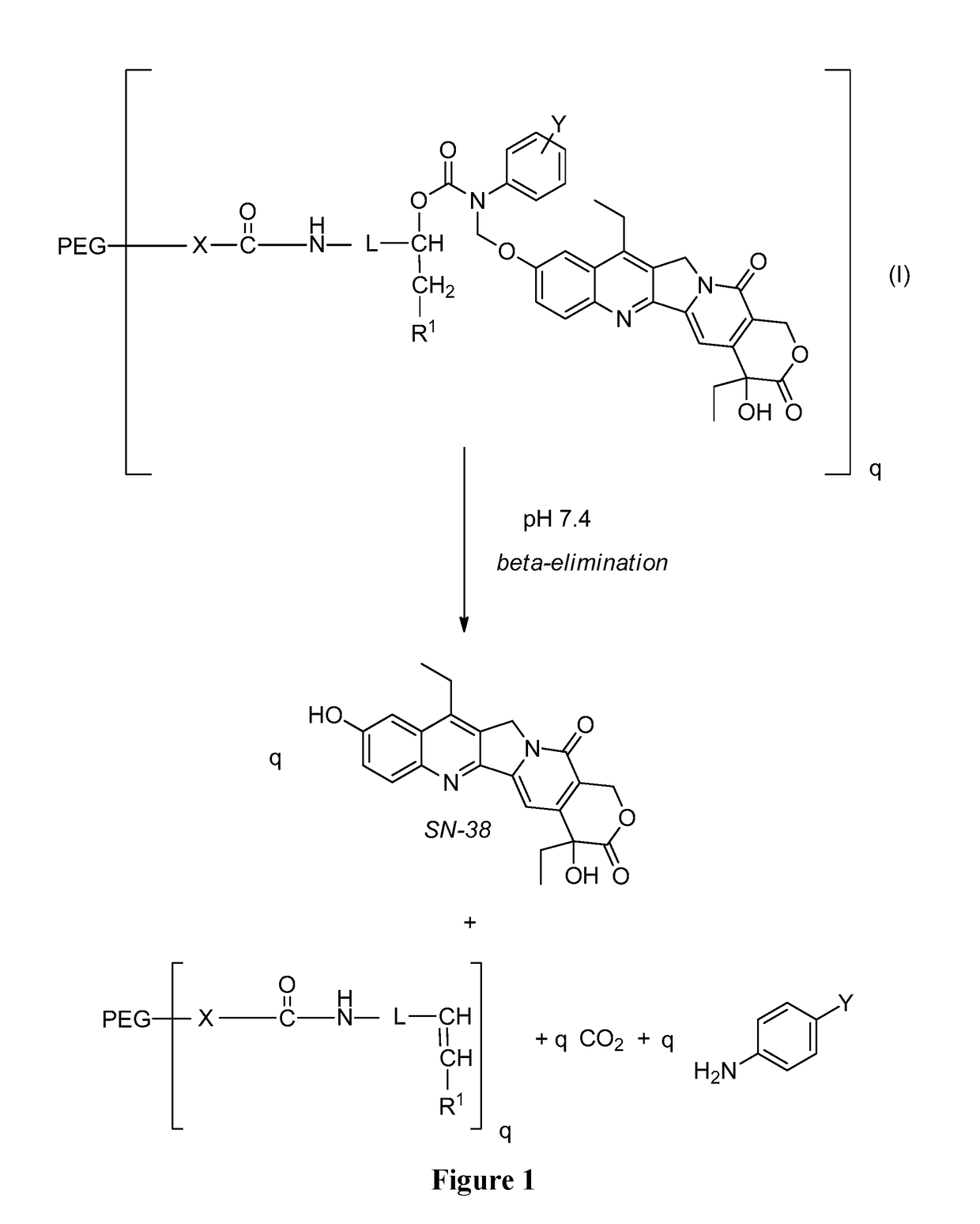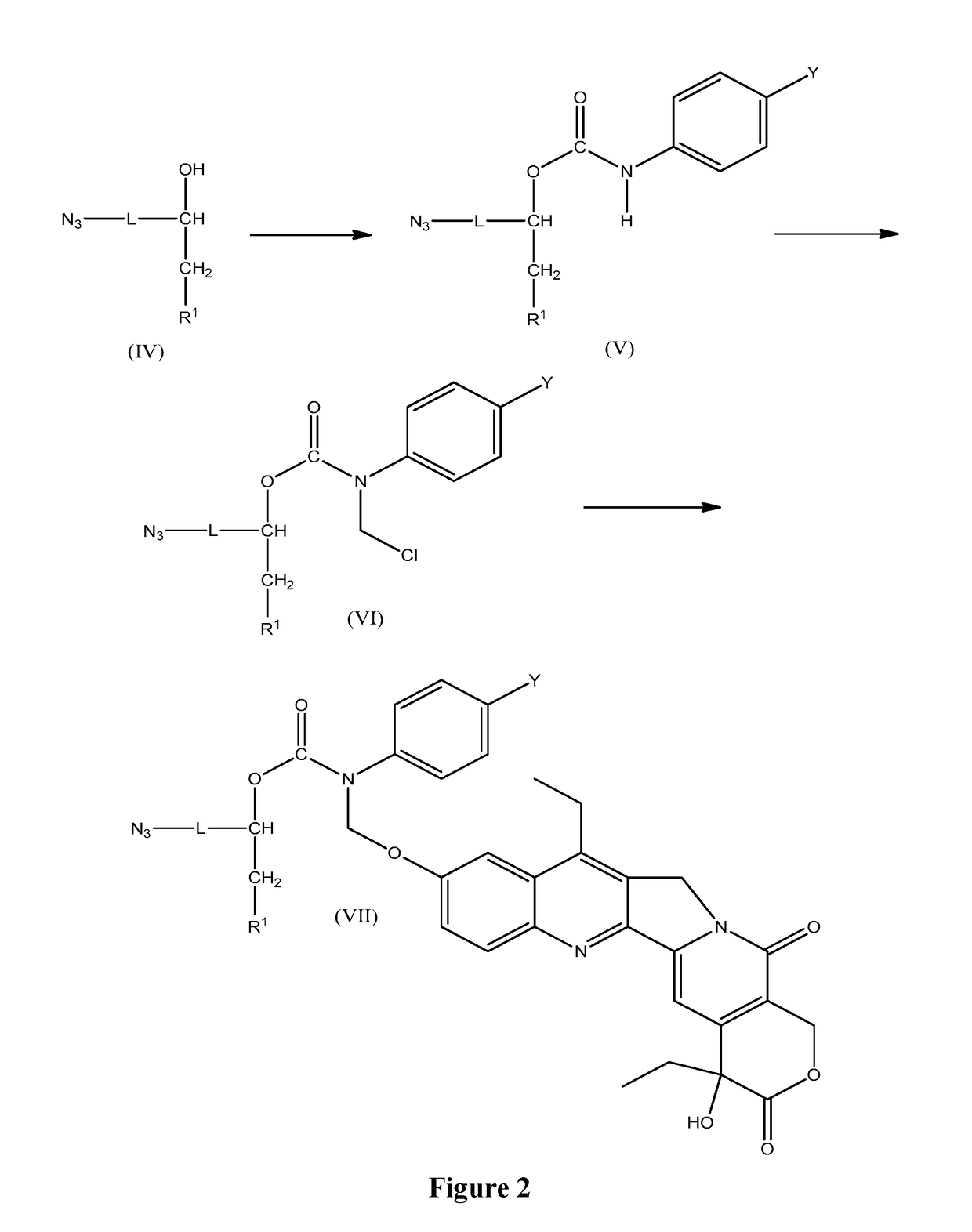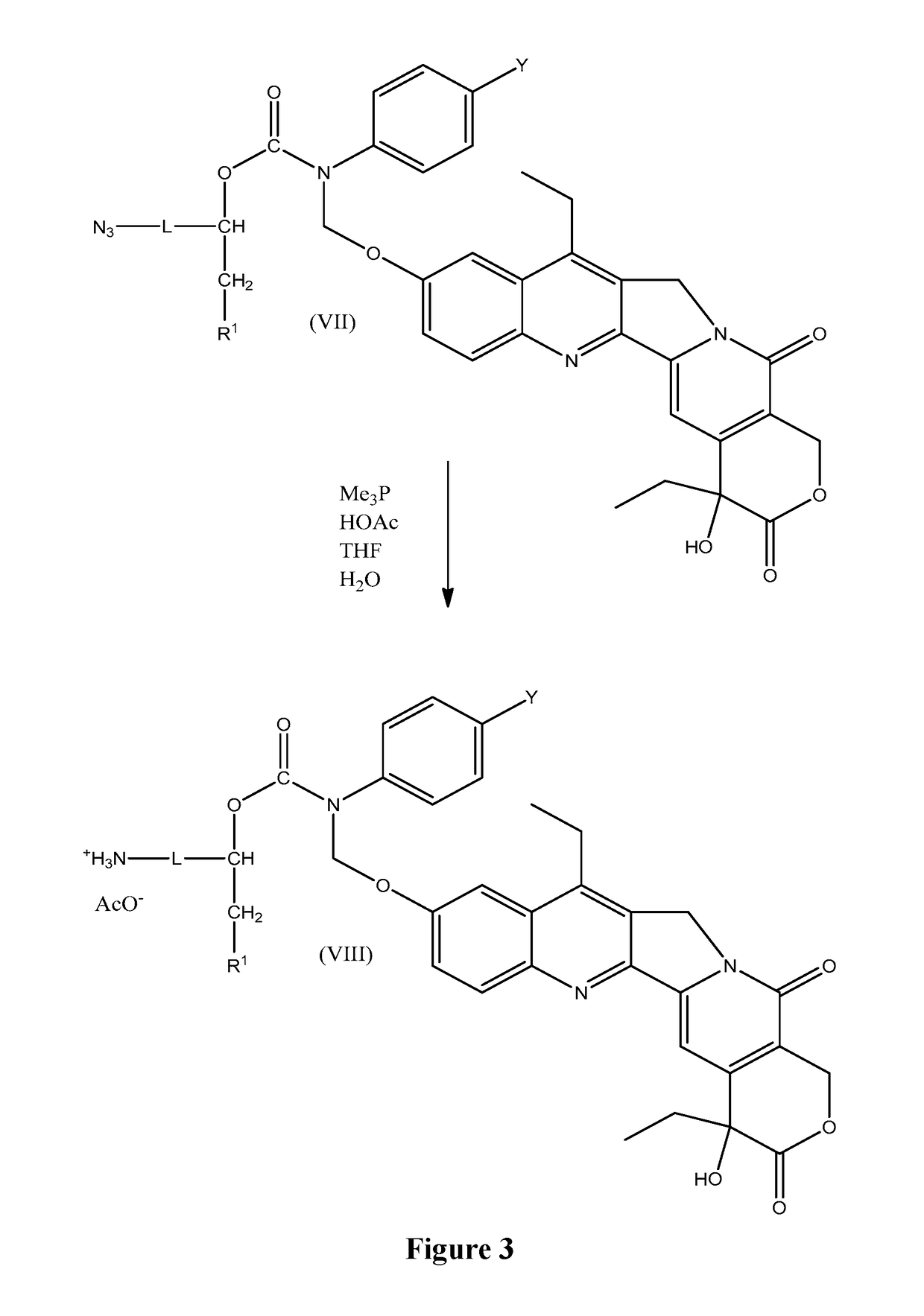Slow-release conjugates of sn-38
a technology of sn-38 and slow-release conjugates, which is applied in the direction of drug compositions, organic chemistry, organic active ingredients, etc., can solve the problems of toxic effects on the intestine, not being able to achieve feasible therapeutic strategies, and not being therapeutically useful
- Summary
- Abstract
- Description
- Claims
- Application Information
AI Technical Summary
Benefits of technology
Problems solved by technology
Method used
Image
Examples
examples
[0067]General: HPLC was performed using a Shimadzu HPLC system with diode-array detection. Reversed-phase used a Phenomenex® Jupiter 5 um 300A 4.6×150 mm column thermostatted at 40° C., with a 20-100% gradient of acetonitrile in water containing 0.1% TFA at a flow rate of 1.0 mL / min. Size-exclusion HPLC used a Phenomenex® BioSep™ S-2000 column running 50:50 acetonitrile / water / 0.1% TFA at 40° C. Solutions containing SN-38 were quantitated by UV absorbance at 363 nm in acetonitrile using e=22,500 M−1cm−1. SN-38 was purchased from Haorui (China).
Preparation A
6-azido-1-hexanol
[0068]
[0069]A mixture of 6-chloro-1-hexanol (50.0 g, 366 mmol) and sodium azide (65.0 g, 1000 mmol) in 400 mL of water was heated at a gentle reflux for 19 h. After cooling to ambient temperature, the mixture was extracted 3×200 mL of EtOAc. The extract was washed 1×100 mL of water, 1×100 mL of sat. aq. NaCl, then dried over MgSO4, filtered, and evaporated to yield 44.9 g (86%) of a colorless oil. 1H-NMR (400 MHz, ...
preparation b
6-azidohexanal
[0070]
[0071]Trichloroisocyanuric acid (12.2 g, 52.5 mmol) was added to a vigorously-stirred solution of 6-azido-1-hexanol (7.2 g, 50.0 mmol) in 100 mL of dichloromethane cooled on ice. A solution of TEMPO (0.080 g, 0.51 mmol) in 2 mL of dichloromethane was added dropwise to the resulting suspension. After 10 min at 4° C., the suspension was allowed to warm to ambient temperature and stirred for an additional 30 min. TLC analysis (30% EtOAc / hexane) indicated complete reaction. The suspension was filtered through a 1 cm pad of Celite using dichloromethane. The filtrate was washed 2×100 mL of 1 M Na2CO3, 1×100 mL of water, 1×100 mL of 1 N HCl, and 1×100 mL of sat. aq. NaCl, then dried over MgSO4, filtered, and evaporated to yield 9.8 g of an orangish oil. This was dissolved in a small volume of dichloromethane and chromatographed on SiO2 (80 g) using a gradient of 0-20% EtOAc / hexanes to provide 6.67 g (47.3 mmol; 95%) of the aldehyde as a colorless oil. 1H-NMR (400 MHz, C...
preparation d
N,N-diethyl 4-nitrobenzamide
[0074]
[0075]A solution of 4-nitrobenzoyl chloride (18.6 g, 100 mmol) in 100 mL of acetonitrile was added dropwise over 30 min to a stirred ice-cold solution of diethylamine (15.5 mL, 150 mmol) and sodium hydroxide (6.0 g, 150 mmol) in 150 mL of water. After completion of addition, the mixture was allowed to warm to ambient temperature and stirred for an additional 1 h. The mixture was extracted 3×100 mL of CH2Cl2, and the combined extract was washed 1×100 mL of water, 1×100 mL of 1 N HCl, and brine. After drying over MgSO4, the mixture was filtered and evaporated to dryness to give a crystalline mass. Recrystallization from 80 / 20 hexane / ethyl acetate provided 20.0 g of product as pale yellow crystals (90%). 1H-NMR (400 MHz, CDCl3): δ 8.27 (2H, m), 7.54 (2H, m), 3.57 (2H, br q, J=6.8 Hz), 3.21 2H, br q, J=6.8 Hz), 1.27 (3H, br t, J=6.8 Hz), 1.12 (3H, br t, J=6.8 Hz).
Preparation E
4-(N,N-diethylcarboxamido)aniline
[0076]
PUM
 Login to View More
Login to View More Abstract
Description
Claims
Application Information
 Login to View More
Login to View More - R&D
- Intellectual Property
- Life Sciences
- Materials
- Tech Scout
- Unparalleled Data Quality
- Higher Quality Content
- 60% Fewer Hallucinations
Browse by: Latest US Patents, China's latest patents, Technical Efficacy Thesaurus, Application Domain, Technology Topic, Popular Technical Reports.
© 2025 PatSnap. All rights reserved.Legal|Privacy policy|Modern Slavery Act Transparency Statement|Sitemap|About US| Contact US: help@patsnap.com



